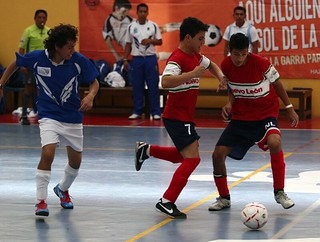 This semester I was blessed and honored to teach an amazing group of kids who were coachable. Coming from an athletic background, this concept of being “coachable” is one of the most valuable traits that a coach can have in a player. The coachable player is one who may not have the best skills or natural talent, but is one who takes feedback to heart and does something with it to improve his performance. I have had the benefit of working with some amazing coaches, and they have definitely influenced how I coach students as they learn Spanish. It intrigues me that many of our high-performing students have lost this ability; they are so fixed on grades that they miss the journey and the pleasure of learning.
This semester I was blessed and honored to teach an amazing group of kids who were coachable. Coming from an athletic background, this concept of being “coachable” is one of the most valuable traits that a coach can have in a player. The coachable player is one who may not have the best skills or natural talent, but is one who takes feedback to heart and does something with it to improve his performance. I have had the benefit of working with some amazing coaches, and they have definitely influenced how I coach students as they learn Spanish. It intrigues me that many of our high-performing students have lost this ability; they are so fixed on grades that they miss the journey and the pleasure of learning.
This particular crew came to me scattered all over the skill map. Initially they were daunted by tackling this class–it’s taught almost all in Spanish, and it’s standards-based, so things like homework play a very minor role in their grades. It was an uphill battle that still is not completely won to convince them that we wanted to highlight what they COULD do and work together on areas where they needed improvement. Trying to convince them that they could make mistakes and still “score well” was a challenge too–they are so conditioned to the contrary.
All of this brings us to a tool that became one of my best strategies: Choose Your Own Adventure. Inspired by work done by Sara-Elizabeth Cottrell (of this blog) and Laura Sexton (sraspanglish.blogspot.com) and a similar project I had done a long time ago, I decided to offer students choices in what they studied and in particular, the ability to choose activities that addressed their areas of needed improvement. Based on last semester’s final exam data, it was clear that we needed to include more listening and reading into their studies. We also live in a culturally rich area where the opportunities to speak Spanish are just a few steps outside their doors. I developed a menu of options split among reading, listening, and culture/speaking, and students had to complete one a week for nine weeks. The only restriction I placed on them was that they had to complete at least 2 listening and 2 reading; the rest were completely their choice.
I also encouraged them to pick almost any topic that interested them and to explore it. My student who wants to be an architect was fascinated by Gaudí’s Sagrada Familia and wanted to know more about it. Great! Two students fell in love with Fonseca and found out that he was coming to town, so they bought tickets (with parental permission) and went to the show…to find out that it was a 21 and over show. That turned into a lesson in being a good consumer and how to ask for your money back 🙂 From a language perspective, many students just plain got better at Spanish because they were reading it and listening to it on their own time. Finally, there is also something to be said for the fact that some of my struggling students looked at this assignment early on as something that they could be successful on, and that inertia carried over to other aspects of class.
Remember “coachable”? Imagine what your class would be like if your students–or even most of them–were coachable. That’s what happened in this class, and it was awesome. Sure, students still struggled, but they invested in the process of improvement. I am convinced that giving them choice, such as on this assignment, was a key part of this journey. But don’t just take my word for it; here are comments that they made on the end of course survey:
- I liked it because it showed how Spanish is used through everyday activities
- I didn’t like it that much, but that could be because I did not do many of the fun ones
- I liked that we could choose what we wanted to do. I didn’t like that it was every week. Maybe you could give people the option to do things that aren’t on that sheet, let them come up with their own activity.
- I liked how we had the freedom to pick whatever we wanted and it helped me learn a decent amount
- I liked how it encouraged me to experience Spanish outside of class, but I felt like I couldn’t do some of the adventures, so I was stuck with the same few.
- I thought it was a good idea but some of the choices could have been better, some seemed a lot easier than others and some like going to restaurant took too much planning
- I liked how we could chose anything and research it and it immersed me into Spanish culture and I learned more about the language
- Most of the stuff I would have done on my own anyways so I liked it
- I thought choose your own adventure was fun and helped me in general. I liked all the options I had, but I didn’t like when we had to do one when we already had a lot of homework that day because it made me fly through it faster than I should have.
- It was cool being able to do the thing you wanted to
- “I liked choose your own adventure, especially all the different opportunities to learn about different Spanish cultures. My favorite one was getting to try different foods.
- I did not like choose your own adventure. I did like the easy ones though. I didn’t like having to do one every week especially when i ran out of the easy ones. I would add more options for the adventure.
And finally, one student said he “improved everywhere considering where I started from” and cites Choose Your Own Adventure as the tool that was most effective in helping him learn Spanish.Reading these comments, I find it interesting that several students did create projects of their own, but some of their classmates in the same period are asking for the option to do exactly that. It was an option available to all.
My evaluation: The feedback is strongly positive, and the intangible effect of a positive vibe in the classroom was critically important to me. I will definitely emphasize the option of creating your own assignment more, perhaps by highlighting those who do. I will also try to include them in adding more options for their menu. I’m interested to see what we can do about turning this into a paperless or at least less-papered project. Their feedback is so helpful, even those who didn’t like it, because even the coach has to be coachable for a team to win.
By Bethanie Carlson Drew.

Bethanie studied athletic training/sports medicine because she wanted to… and Spanish because her dad made her. After working in college athletics, she realized that she liked Spanish after all and that it opened doors that she couldn’t have envisioned, thereby proving her dad right. Twenty years later, she is still teaching high school Spanish and loving it, especially treasuring the sweet spot moment when her students are able to be themselves, but in Spanish. She fled the snowy tundra of the midwest 15 years ago to live in magnificent North Carolina where school is cancelled if a single flake falls. She is married to an amazing husband and they have two incredible kids and Natalie, the wonderdog.
3 Comments
Comments are closed.




I like this idea. Next year I will endeavor to incorporate this into my classes, especially my level 3s. Unfortunately we live in the Northeast and while there are hispanics living in the area, there aren’t many obvious opportunities outside their door.
I lile this concept a lot. I used to give “free choice homework” which sounds similar. I’ve also done free choice computer lab listening and reading days with success. I’d love to see the documents you gave your students! I am teaching a college prep level 2 Spanish next year and maybe it is time for me to revisit this idea!
[…] when fabulous NC teacher Bethanie Carlson Drew (who has guest-posted on Musicuentos before) tweeted requesting recommendations for a good resource for authentic […]